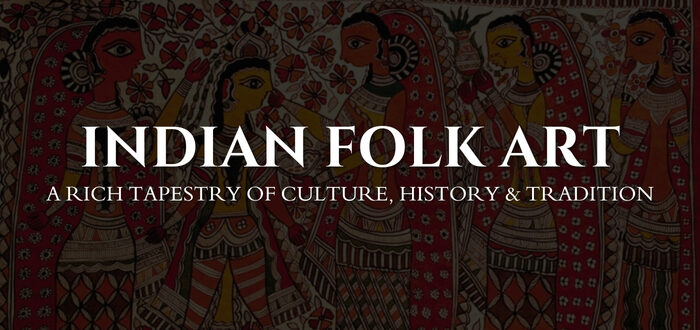Indian Folk Art: A Rich Tapestry of Culture, History, and Tradition
Indian folk art—one of the vibrant scrolls—sings the stories of India’s rich cultural heritage. It is more than just an art form with some brush strokes and hues. Going beyond just a visual appeal, folk paintings in India is a treasure trove of traditions and beliefs incorporated into the lives of people across the nation.
In the past, folk arts were a way for people to express themselves and pass down traditions from generation to generation. Today, Indian folk art continues to thrive, adapting to contemporary contexts while retaining its traditional essence. From the ancient carvings on cave walls to smooth brush strokes on soft canvas, we have come so far today.
Origins of Indian Folk Art
Indian folk art has its roots deeply embedded in the rural and tribal communities of the country, dating back thousands of years. These art forms served as both a mode of storytelling and a record of communal beliefs. Historically, folk art was created for religious and ritualistic purposes, often painted on the walls of homes, temples, or public spaces to depict deities, legends, or natural elements. Despite its simplicity, folk art is often layered with meaning, showcasing the spiritual life and connection to nature. One notable feature of folk paintings in India is its resilience. It has adapted over centuries, absorbing influences from invasions, migrations, and religious changes. This ability to evolve has allowed many folk art forms to survive into the modern era, albeit in fragmented or commercialized forms.
Father of Indian Folk Art
There is no single figure who can be definitively called the “Father of Indian Folk Art,” However, one figure often celebrated for his role in reviving and promoting Indian folk art on a national level is Jamini Roy. A prominent modern artist, Roy drew inspiration from Bengali folk art, particularly the Kalighat paintings, and incorporated these styles into his own work. By blending traditional and modern elements, he helped bring attention to India’s folk art traditions during the early 20th century.
Evolution of Indian Folk Art Through Different Periods
Indian folk art has evolved remarkably over the centuries. From ancient cave paintings to modern-day adaptations, each period has left a distinct imprint on the country’s folk art traditions.
-
Prehistoric Period
The roots of Indian folk art can be traced back to prehistoric times, as seen in cave paintings such as those in Bhimbetka (Madhya Pradesh)
-
Vedic and Epic Period
The Vedic period witnessed a shift toward more structured religious rituals and practices, and folk art began to reflect the growing influence of Hinduism.
-
Mughal Period
The Mughal period brought a fusion of Persian, Islamic, and Indian artistic traditions.
-
Colonial Period
During British colonial rule, Indian folk art underwent both decline and revival. On the one hand, industrialization and British policies displaced traditional artisans, leading to the decline of many folk art forms. On the other hand, nationalist movements sought to revive indigenous art forms as part of the Swadeshi movement.
-
Post-Independence Period
After India gained independence, efforts to preserve and promote folk art gained momentum. The government established institutions such as Cottage Industries and Handicrafts Development Boards to provide support to traditional artisans.
Types of Indian Folk Art in India
India’s vast diversity is mirrored in the multitude of folk art forms that are practiced across its regions. Below are some of the most prominent styles of Indian folk art:
-
Madhubani Painting (Bihar)
Folk Art Madhubani style is an art, originating in the Mithila region of Bihar, is one of the most famous forms of Indian folk art. Traditionally painted on walls or floors, it is now commonly done on paper and cloth. The themes of Madhubani art often revolve around nature and mythology, with images of gods, animals, and plants being prominent.
-
Warli Painting (Maharashtra)
Warli art is an ancient tribal painting technique practiced by the Warli tribe in Maharashtra. Unlike other forms of Indian folk art that use bold colours, Warli art is characterized by white stick-like figures painted on a brown background. These paintings often depict scenes from rural life, including farming, dancing, hunting, and religious rituals.
-
Pattachitra (Odisha and West Bengal)
Pattachitra is a traditional form of scroll/ cloth painting that originated in the eastern Indian states of Odisha and West Bengal. The word “Pattachitra” is derived from the Sanskrit words “patta,” meaning cloth, and “chitra,” meaning picture. Pattachitra paintings are known for their intricate details, mythological themes, and vibrant colours.
-
Phad Painting (Rajasthan)
Phad painting is a traditional Rajasthani folk art painting, used to depict stories of local deities, such as Pabuji and Devnarayan, on long scrolls or ‘phads.’ These scrolls are often used in religious storytelling, accompanied by folk singers narrating the legends depicted in the artwork.
-
Gond Art (Madhya Pradesh)
Gond art of Madhya Pradesh is the traditional art of the Gond tribe known for its distinctive style that uses dots and dashes to create intricate patterns. Gond art often portrays animals, trees, and birds, highlighting the tribe’s close connection to nature.
Themes in Indian Folk Art
The themes of Indian folk art are deeply intertwined with the lives and beliefs of the rural and tribal communities from which they originate. Some of the recurring themes include:
- Nature and Animals: Many folk art forms, including Gond and Madhubani, place great emphasis on nature and animals.
- Mythology and Religion: Indian folk art is deeply spiritual, with many art forms focusing on stories from Hindu mythology, including gods, goddesses, and epic tales.
- Daily Life and Celebrations: Folk art frequently portrays the rhythm of rural life, from agricultural activities to festivals and rituals.
Protecting Indian Folk Art from Extinction
Indian folk art is an integral part of the country’s cultural and artistic heritage. Despite their historical and cultural significance, Indian folk art is rapidly fading. The artisans who have long been the custodians of these traditions are struggling to keep them alive in the face of numerous challenges like globalization, lack of support for artisans, urbanisation, lack of documentation and many more.
Preservation of Indian folk art requires a concerted effort from both the government and civil society, including:
Increased financial support for artisans, including grants, subsidies, and fair trade policies.
Educational initiatives that teach young people about the value of folk art and provide training in these traditional crafts.
Promotion and awareness campaigns that highlight the importance of folk art in Indian culture.
Conclusion
Indian folk art is an invaluable part of the country’s cultural legacy. Its vivid expressions of life, nature, mythology, and spirituality offer a unique lens into the traditions and beliefs of India’s rural and tribal communities. By fostering awareness, supporting artisans, and incorporating folk art into modern-day contexts, we can help protect and preserve this artistic heritage for generations to come.
Giftex Art October: Masterpieces Under the Hammer
Join us this 14-15 October 2024 at the Giftex Modern and contemporary art auction, where history meets the present in an extraordinary collection of famous works from renowned artists like Jamini Roy and more. Don’t miss your chance to own a piece of art history! This exclusive event offers a rare opportunity to acquire works that inspire and captivate.
Mark your calendar and get ready to bid on brilliance!






